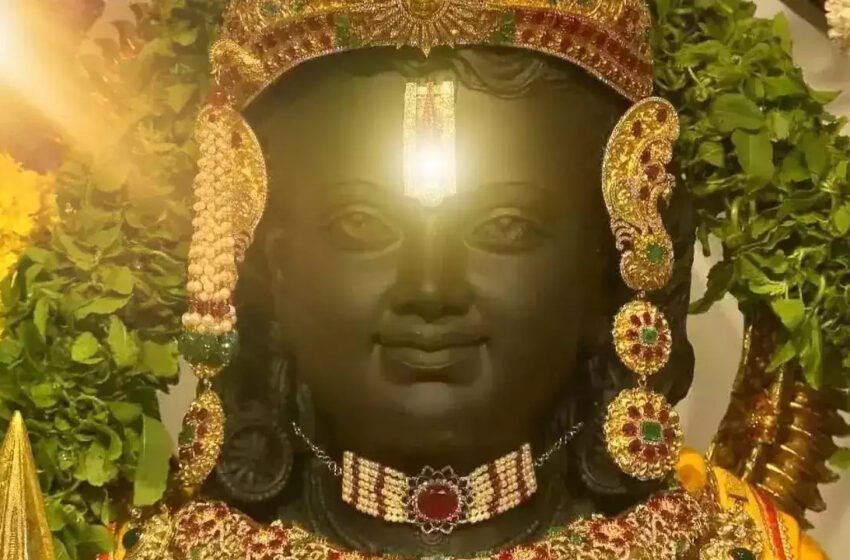Surya Tilak : Exploring the Celestial Interplay in Ayodhya Ram Mandir and Ancient Indian Temples

n 17th April, as the festivities of Ram Navami were celebrated with great pomp and splendor, the Ram temple in Ayodhya experienced an extraordinary moment. Amidst the devout chants and celebrations, a beam of sunlight elegantly descended upon the forehead of the revered Ram Lalla idol. This remarkable event, which occurred precisely at 12:01 AM, was orchestrated through a sophisticated system of mirrors and lenses ingeniously installed within the temple premises.
Behind this awe-inducing event, was a team of dedicated scientists from the Indian Institute of Technology, Roorkee and the Indian Institute of Astrophysics; who had been appointed by the temple trust. The convergence of spirituality and scientific ingenuity illuminated the sanctum with an aura of divine grace and captivated the hearts of devotees and onlookers alike.

How exactly was this feat achieved? The team of scientists behind this marvel, admitted that the task was challenging. It required “precise coordination to direct sun rays from an upper floor onto Ram Lalla’s forehead using specialized equipment, aligning with the earth’s movement”. To achieve this, a mechanism was specifically designed in a way that sunlight from the outside would be reflected to create a “tilak” shape on the forehead of the idol.
According to reports, this mechanism comprises a gearbox configured with reflective mirrors and lenses. On 17th April, at 12:01 PM, it ingeniously directed sunlight from the third floor near the shikara to precisely illuminate the garbhagriha (sanctum sanctorum). Crafted with meticulous attention to detail, the tilak apparatus incorporates components fashioned from brass and bronze materials, which were chosen for their resistance to corrosion. Furthermore, the design of the optical path, pipings, and tip-tilts prioritizes longevity and minimal maintenance, by cleverly omitting the use of springs. Additionally, the traditional Indian alloy Pancha Dhathu was also used in the construction of the Surya Tilak apparatus

The Indian Institute of Astrophysics (IIA), headquartered in Bengaluru, played a pivotal role in demarcating the calculations essential for the precise alignment of the sun beam onto Ram Lalla’s idol. Professor Karandikar stated, “Detailed calculations show that the English calendar date of Sri Ram Navami repeats every 19 years. Calculating the position of the Sun on these days requires expertise in astronomy.” From now onwards, the initial mirror within the apparatus, denoted as M1, will have to be adjusted annually to align with the Sun’s position to facilitate the Surya Tilak projection.
Professor Karandikar also informed on X, that ‘Optica’, a company based in Bangalore, was responsible for indigenously manufacturing the lens, mirror, and mirror-holders, while the on-site implementation of the opto-mechanical system was undertaken by CBRI, Roorke. A Government official present at the site revealed that the IIA team had meticulously adjusted the opto-mechanical system to accommodate the ongoing construction of the temple. With the Ram Mandir complex slated for completion in approximately two years, these adjustments ensure that the mechanism to facilitate this celestial spectacle can be seamlessly integrated into the evolving structure.
Former ISRO scientist, Manish Purohit, elucidated the planning that went behind the Surya Abhishek mechanism. He emphasized the incorporation of three critical factors to ensure the illumination of Ram Lalla’s forehead by the Sun’s rays. These factors include archaeoastronomy, which accounts for the historical astronomical alignments; the ‘Metonic cycle’ – which predicts the recurrence of lunar phases; and the analemma which factored in the Sun’s apparent motion throughout the year. In this way, this collaborative effort between the scientific community and temple authorities showcased a brilliant commitment to preserve tradition while embracing technological advancements at the same time. This was indeed a harmonious fusion of ancient reverence and modern innovation within the sacred precincts of the Ram temple in Ayodhya.

It is remarkable to note that the tradition behind Surya Abhishek goes back hundreds of years. In Ayodhya, the mechanism to facilitate Surya Abhishek utilized modern lenses and mirrors to meticulously direct the Sun’s rays onto Ram Lalla’s forehead. On the other hand, traditionally; Ancient Indian temples often integrated astronomically calculated openings which would be strategically placed in and around the garbhagriha (sanctum sanctorum) to enable direct sunlight to illuminate the deity on particular days. This fusion of tradition with technology not only highlights the reverence for celestial phenomena in Indian culture but also reveals the meticulous attention to detail in their architectural design. By harmonizing ancient wisdom with contemporary innovation, the Surya Abhishek at the Ram temple in Ayodhya serves as a strong testament to the enduring legacy of India’s rich cultural heritage.

This architectural practice of blending the magic of sun rays with the architecture of temples can be observed in several other notable Indian temples. The Konarak Sun temple in Odisha and Modhera Sun temple in Gujarat exemplify this technique perfectly. The 13th-century Konark Sun Temple’s design ingeniously allows sunlight to bathe the temple, especially during sunrise. The architectural plan ensures that the initial rays of the Sun delicately touch the temple’s main entrance, filtering through various doorways to illuminate the sacred garbhagriha within. However, ongoing conservation efforts have necessitated the closure of the doors leading to the garbhagriha and the main deity, restricting public access to these revered inner sanctums of the Konark Sun Temple. Similarly, the Modhera Sun Temple, dating back to the 11th century, experiences a similar extraordinary phenomenon. Twice a year, sunlight streams into the temple, delicately illuminating the idol of the Sun God, offering worshippers a rare and captivating spiritual experience.
Located in Tamil Nadu, the Suriyanar Kovil temple stands as another witness to ancient architectural and astronomical ingenuity. Constructed in the 11th – 12th century, this temple is revered not only for its religious significance but also for its architectural brilliance. During specific times of the year, sunlight penetrates the temple’s sanctum, illuminating the principal deity, Suriyanar, along with his consorts Ushadevi and Pratyusha Devi. Pilgrims and tourists alike flock to witness this celestial phenomenon and marvel at the intersection of faith and science.

Situated in Nagalapuram district, Andhra Pradesh; the Nanarayanaswamy Temple annually conducts a five-day Surya Puja Mahotsavam. Throughout this festival, the temple experiences a unique phenomenon as the Sun’s rays infiltrate its sanctum, undergoing a daily progression. Over the course of five days, the trajectory of the Sun’s rays within the temple shifts, symbolizing a significant journey. Specifically, these rays travel from the deity’s feet to the navel in the garbhagriha, representing the revered ‘Matsya avatar’ of Lord Vishnu. This special occurrence during the Surya Puja Mahotsavam not only adds to the spiritual ambiance of the temple but also serves as a reminder of the skill of the Ancient Indian architects and builders who succeeded in depicting the interplay between mythology and natural phenomena.

Similarly, famous for its unique bi-annual event “Kiranotsav” is the Mahalakshmi temple in Kolhapur, Maharashtra. The Kiranotsav, literally meaning the “festival of the sun ray”, is a sacred event observed at the temple. During this auspicious occasion, the sun’s rays align perfectly to illuminate the deity’s idol within the temple’s sanctum sanctorum through the Garud Mandap. The radiant sunbeams grace the feet of the Goddess Mahalaxmi twice a year; and on two other days, they illuminate the central part of the idol. On two particularly special days, the entire idol is bathed in the warm and divine sunlight, signifying a profound moment of spiritual connection and celestial blessing.
In the Jain school of Architecture too, this aspect of connecting natural phenomena with religious architecture was given a special role. Prominent is the Koba Jain Temple in Ahmedabad, Gujarat. Every year, the Koba Jain Temple witnesses the remarkable Surya Tilak phenomenon. Like clockwork, at precisely 2:07 pm, for a fleeting three minutes, the Sun’s rays delicately caress the forehead of the marble deity, Mahaveerswami. This annual celestial event is a spectacle revered by millions of Jains worldwide, drawing pilgrims from far and wide to witness the divine alignment.

The Jain Temple of Ranakpur in Rajasthan is another shining example. Nestled within the Aravali Range, the Ranakpur Temple, dating back to the 15th century, stands as a marvel of Jain architecture. Constructed from clear white marble, its design too ingeniously welcomes sunlight into its inner sanctum, bathing it in celestial radiance. The temple’s layout is meticulously crafted to ensure that the Sun’s rays gracefully illuminate the idol of the Sun god directly. This seamless integration of architecture and sunlight enhances the temple’s spiritual atmosphere and also captivates visitors with its ethereal charm and profound symbolism.
From the Suriyanar Kovil temple in Tamil Nadu to the Ranakpur Jain Temple in Rajasthan, each site showcases the ingenuity of ancient Indian craftsmen and their reverence for celestial phenomena. These temples not only stand as architectural marvels but also as living testaments to the profound connection between humanity and the cosmos.These temples are a noteworthy part of the rich cultural heritage of India and even today, continue to invite visitors to contemplate the mysteries of the cosmos while paying homage to the radiant Sun God.


